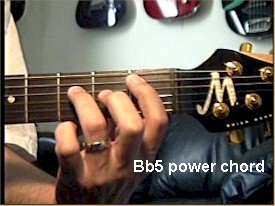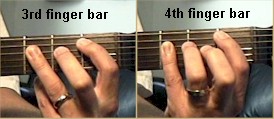Scroll through the lesson and click on notation/video/audio links to load the interactive players.
Please subscribe to get full access to all lessons for only $7.95/month PLUS 1 week free trial.

Riff Interactive lessons are
LESS expensive and
MORE interactive than alternatives!
More Info
|
|

Beginning Guitar
IV - Lesson 2
Bar Chords - A Position
check your tuning
Lyle:
Even though I'm making this lesson for beginning guitarists, remember that the
bar chords can be very tough to play at first. I bet there are a few of you out
there who can relate.
James:
Definitely!
dan2: My wrist is still killing from the last lesson.
:)
Lyle: Don't overdue it! You'll build up strength
in time. Last lesson you worked on bar chords that moved up the neck using the
open E position shapes. This lesson will be just like that, only using the
shapes from the open A position chords you learn several lessons ago with me.
Take a look at the 5 basic chords in the open A position:
open A
position chords
Lyle:
You're going to take each one of those chord shapes and move them up the A/5th
string to get to all the different keys. Here's all the note names on the first
12 frets of the 5th string:
notes on the 5th string
MArk: major A
= Mi ?!?
Lyle: A = major/M/Maj/maj/Mj. The chord
letter name all by itself - A, means
major.
dan2:
What's with the circles?
Lyle: Playback the TAB file so you see and hear
it on the virtual neck. The circled notes
are the natural notes up the neck.
Lyle: Let's take the open A chord shape and move
it all 1 fret higher. You'll need to move the open strings up by barring with
your index finger:
A to Bb
Lyle:
Here's another way to play the Bb bar chord. Start with the Bb power chord, then
bar over to just the 2nd string using either the 3rd or 4th
fingers:
Bb5 power
chord

Bb bar chord

Bb chord
George: Got to
strengthen my 4th finger...any tips?
Joel:
yeah... also any tips for strengthening the fret hand or fingers.. pushups? lol.
vitamins or steroids? ;)
Lyle: Pushups, pinky pushups. I
have an old tennis ball laying around the house and I use that in my left hand
to squeeze gently with my little finger for exercise.
Lyle: I find it comfortable to use my 4th
finger instead of my 3rd finger to make these major bar chords like this. Once
my hand moves higher up the neck, like around the 5th fret, I switch to my 3rd
finger.
Lyle: Practice playing all of these chords up and
down the neck. Make each note ring clearly. This is hard for some beginners,
remember, but at least you are learning this now. Also, think of this as a chord
library for future reference.
major chords in the A position
Lyle:
Practicing those chords up and down the neck is a good exercise to strengthen
your fretting hand. Mute the 6th string with the tip of your index finger. You
are going to use those major chord shapes a lot over the years, get used to
them!
Lyle: Here's the opposite of the major chord, the
minor chord. Take the plain open Am chord and move its shape up the neck. Your
index finger will now bar from the 5th to the 1st string:
minor
chords in the A position
Lyle:
The minor chords found there at the first 4 frets you'll be using in many songs.
Bbm, Bm, Cm, and C#m are not found in any open position chords. This will be
your best place to find them.
Lyle: The other chords besides major and minor
that you will use a lot are the dominant 7 chords:
dominant 7
chords in the A position
Joel: Cm's
used in country and some other stuff.. Willie Nelson uses
incessantly.
Lyle: Yes, depending on what key they like to
sing in, you'll run into those chords a
lot.
Lyle: The fancy sounding major 7 chords are used
in jazz, blues, even rock:
major 7 chords in the A position
Lyle:
Now the opposite of the major 7 chord is the minor 7
chord:
minor 7
chords in the A position
Lyle:
So much to memorize. Do the best you can at this early stage of your
development.
Joel: It looks easy on paper.. more difficult in
practice.
Lyle: Major chords have a strong and plain sound,
minor chords have a softer sound, dominant chords have a bluesy
sound.
bluesguitarmp3: I love the sound of minor
chords...
Lyle:
Good!
bluesguitarmp3: ...and the sevenths just rounds it out,
thanx.
Lyle: I made a couple of small practice jams for
you. Here's the first one:
progression 1
progression
1
Lyle:
Each chord gets a strum on beat one of each measure.
progression
1

Lyle: You can loop the TAB file to practice with,
or try playing along to this looping jam track:
Jam Track -
progression 1
Lyle:
Here's another progression that mixes up the types of chords a
little:
progression 2
progression
2
progression
2

Lyle: Try playing along to this looping jam track
for progression 2 once you are ready:
Jam Track - progression 2
oiler_fan9: What's the dif between B7 and
BM7?
Lyle: The difference is:
B7 to
BM7
Lyle:
The B7 chord has the "flatted 7th" in it, the BM7 has a major 7th in it. One
fret difference between the two.
bluesguitarmp3: How about a song teach, a song we all
know?
Lyle: Well, a song....a piece of a song that uses
these chords perhaps....
Lyle: I got one.....here you
go:
exercise
Lyle:
Repeat that progression over and over.
exercise
sammy_andrews:
Lyle....will you tell me the fingerings for a couple of
chords?
Lyle: ok sammy, which
ones?
sammy_andrews: Gmaj7 with a doubled
3rd
Gmaj7 double
3rd
Lyle:
sammy, look at this on the virtual
fretboard. You'll see two notes that are 3rds.
sammy_andrews: Thanks Lyle...the other chord is F#minor7
add 11
F#m11
Lyle: Well, that's a m7 add 11, no 9 in it.
sammy_andrews: Thanks Lyle!
Lyle: You're welcome. Here's a good time to take
a break, see you at the next lesson!
|
<< load notation from left
|
|
<< load audio from left
|
<< load audio from left
|